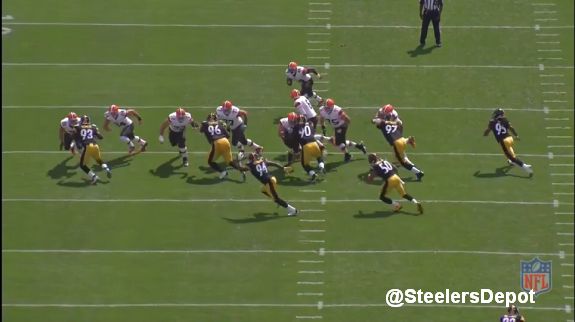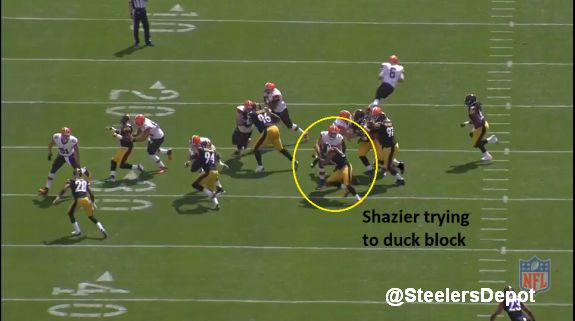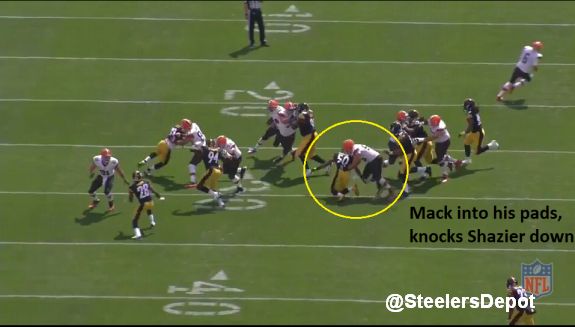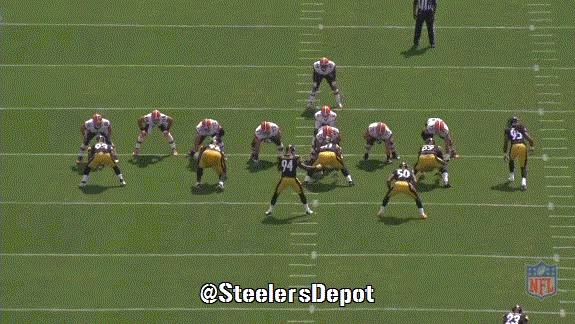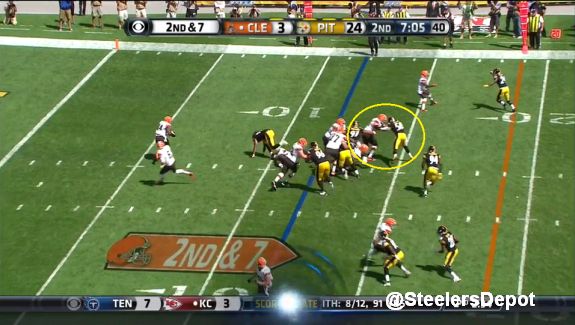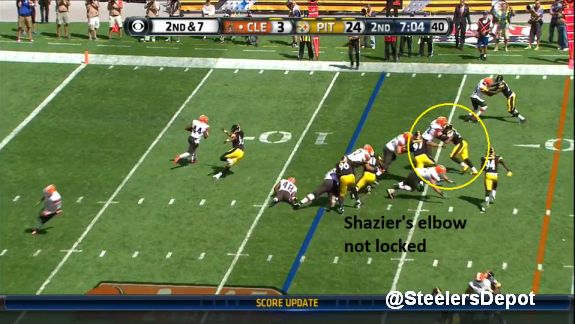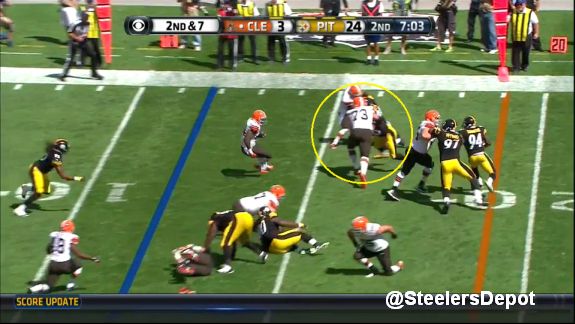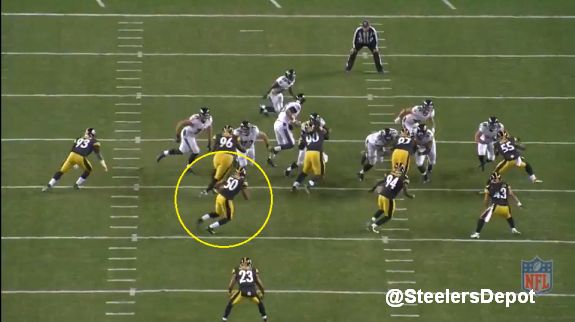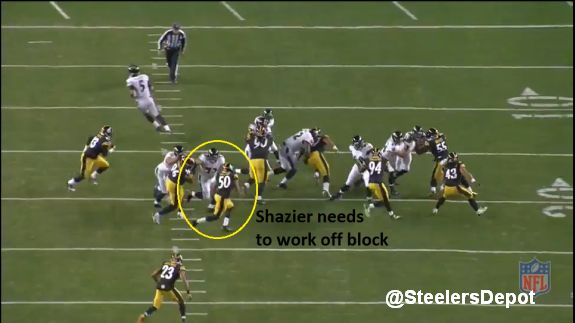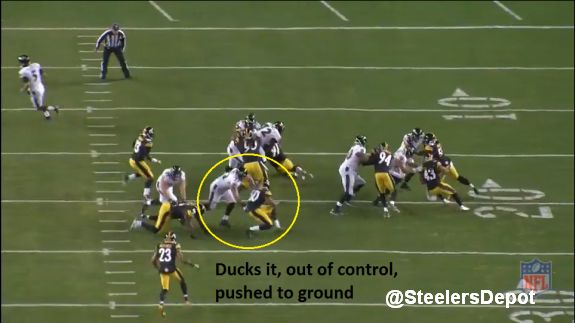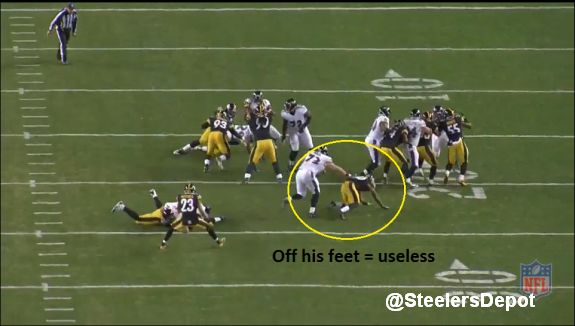There will be several Pittsburgh Steelers under the microscope in 2015, particularly on the defensive side of the football. Ryan Shazier is among that group, a rookie year marred by injury that never let us fully see the type of player he could become.
Like any second year player, you’re looking for improvement in almost every area. But the one that should be singled out is his ability to work off blocks in the run game. That is a fairly well-known weakness by the casual fan.
Upon revisiting the Coaches Tape, Shazier actually did a good enough job of being able to shed blocks from lineman coming directly at him. He played under control and showed active hands to disengage from the block.
Where I thought he would’ve played better but actually fared worse was when he was forced to move laterally. Zone concepts, inside and outside zone runs. There was some awfully bad tape.
He faced a heavy dose of it in versus the Cleveland Browns and Baltimore Ravens.
In our first look, Shazier is asked to move laterally on this outside zone to the Browns’ right. Center Alex Mack works to the second level, meeting the linebacker.
Shazier does a poor job of getting separation from Mack, who is able to get into his body and knock him to the ground. A defender off his feet is a useless one. As a result, Shazier doesn’t fill his gap. All it takes is one player to fail in his run fill to create an explosive play.
The coaching point? Linebackers need to get their inside hand to the far shoulder of the blocker with their elbow locked out. If that elbow is hinged, the blocker can push into you and get into your pads, taking control. There isn’t even any hand use here, Shazier trying to duck under the block. Not going to be effective in the NFL. Old adage of lineman being bigger and stronger, especially when it’s one of the game’s best centers.
Similar issue later in the game. Outside zone, Shazier needs to flow laterally. This time, he gets his hand into the body of left tackle Joe Thomas, but watch the elbow. Never locks out and Thomas is able to eat up the space inbetween, taking control and running him out of the play.
Even beyond that, Shazier doesn’t do a good job of crossing the tackle’s face and getting his outside arm free. Too eager to engage in the block and he gets driven out. If he’s able to stay free, he can theoretically cause the back to slow up and cut inside – Shazier is the force player – to the defense’s help.
I realize Lawrence Timmons overran the play and Cam Heyward gets stuck on his block. Those were contributing factors in Ben Tate’s 25 yard gain but it doesn’t excuse poor technique from Shazier.
The third comes from Week 9 against Baltimore. Like the first example we showed, Shazier doesn’t even try to incorporate his upper body. There’s no hand usage. Inside zone with Shazier flowing to the right.
Shazier needs to throw that inside hand out to keep the lineman at bay and prevent him from delivering a punch. If the running back cuts back, so be it, you’ve maintained your gap and are spilling it to another defender.
Instead, Shazier is again caught trying to duck the block, dipping his inside shoulder. He’s off-balanced, generally out of control, and again, is forced to the ground.
This isn’t some remarkable play by the guard, he simply found some surface area to hit and Shazier’s poor form did the rest. The guard rides Shazier the rest of the play, pinning him to the ground. Again, a linebacker on the ground is a useless one. Have to stay on your feet to compete. He is bailed out by the penetration from Heyward and Steve McLendon, tackling Bernard Pierce for a loss.
Like I mentioned, I was surprised to see Shazier struggle in this area. If anything, I expected the results to be inversed, struggling in a box and best while on the move. I attribute this to Shazier needing to compartmentalize, learning how to play fast and with good technique.
What makes it an even more difficult evaluation is the lack of opportunity to get better during the regular season. After his return in Week 8 through the rest of the regular season, Shazier faced only 23 runs. Not much of a sample size to go off of and hard to be able to see improvement, making 2015 even more critical.

